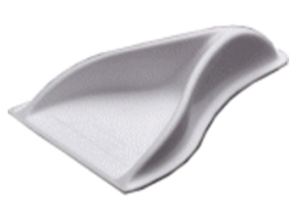Story by Rolf Lockwood - Editor
Vortex generators claim fuel savings Just when you thought all the practical aerodynamic tricks had been uncovered, here comes another one.
And the claim is substantial -- 4%-plus fuel savings, guaranteed, and a six-month payback. Better yet, it really seems to work.
Just hitting the market now, 'Airtab' are small, triangular pieces of ABS plastic about four inches long and three wide tapering to a point, with a sort-of hollowed-out, scoop-like middle. From Aeroserve Technologies of Nepean, Ont., they're obviously heavily 'engineered', and indeed they're specially designed for trucks
They borrow from aviation technology (even the U.S. National Aeronautics and Space Administration, or NASA, says they work) to create a controlled swirl of air, or vortex, behind a van box or trailer or at the gap between tractor and trailer.
Arrayed in a continuous line up the sides and over the top of a van or a tractor, at the trailing edge, they address the problem of air that has to rush in to fill the vacuum left by the truck. The air has to make a sharp bend around the squared-off back of the vehicle, which creates turbulence and thus drag. 'Airtab' produce a vortex of air from each side that extends for several feet behind, thus bridging the tractor-to-trailer gap and/or controlling the way air flows into the vacuum at the back of the truck.
WThat gap is always a challenge, and Aeroserve says that if it's larger than about 18 inches, you'll have power-robbing turbulence. But if you move the fifth wheel forward, you may have too much weight on the steering axle with potential handling problems and tire wear. Most people compromise between fuel economy and handling, and many use cab-side extenders.
These little tabs are said to take that compromise away. An early user of Airtab® is Tilmech Mechanical Enterprises of Tilbury, Ont., a manufacturer with a small fleet of one International 9200 tractor and 10 48-foot van trailers hauling auto parts to Toronto. With meticulous fuel records kept over several years, and a standard run, they represent a good test bed.
Tilmech's Ken Atkinson confirms the 4% fuel-savings figure, saying "There's probably a chance to go further depending on the aerodynamics of the tractor and trailer unit." That 4% saving represents $1000 a year in fuel and tire costs, he says. Among the benefits, according to driver reports, is reduced splash and spray and better visibility to the rear.

